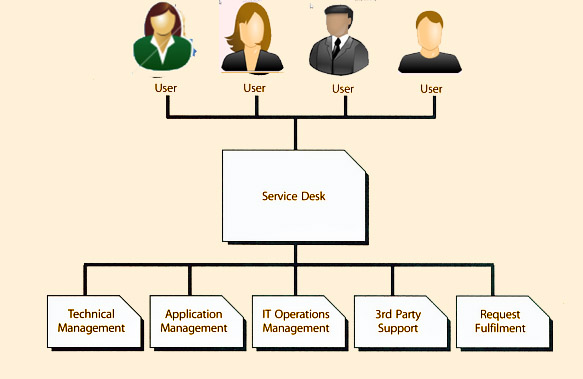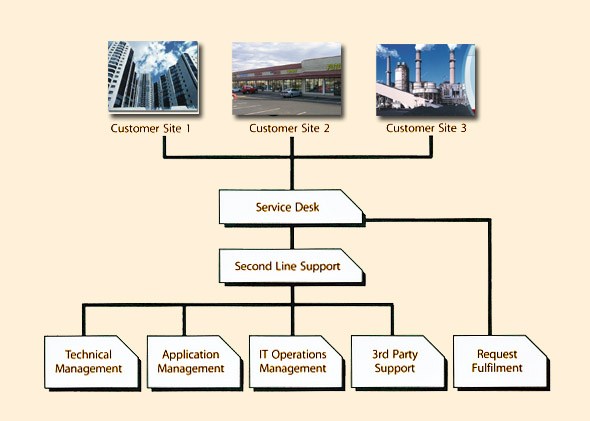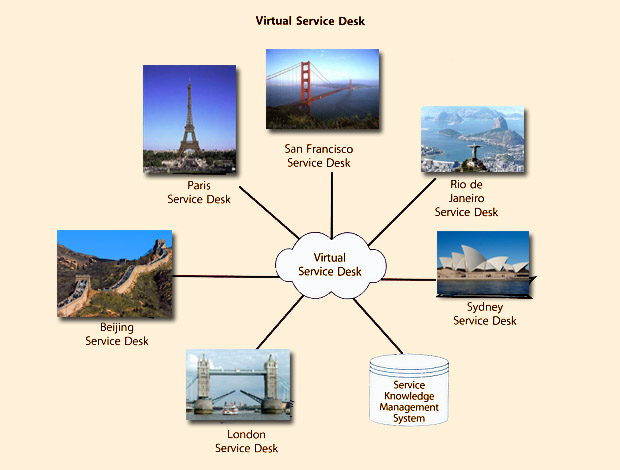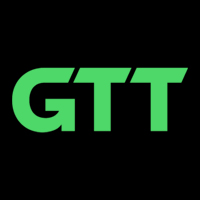
Email Gijs-Jan
How can we help?
Whether you're looking for expert ITSM consulting, cutting-edge technology solutions, award-winning training courses, or hands-on IT support, explore our website and use the search box to easily find the resources, insights, and services you need.
Service Desk Organisational Structure
There primary aim of the Service Desk is to restore the normal service to the users as quickly as possible. In this context restoration of service is meant in the widest possible sense. While this could involve fixing a technical fault, it could equally involve fulfilling a service request or answering a query anything that is needed to allow the users to return to working satisfactorily.

There are many ways of structuring Service Desks and locating them and the correct solution will vary for different organizations. The primary options are detailed below, but, an organization may need to implement a structure that syndicates a number of these options to completely meet the business needs.
Local Service Desk:
Is where a desk is co-located within or physically close to the user community it serves. This often supports communication and gives a clearly visible presence, which some users like, but can often be inefficient and expensive to the resource as the staff is tied up waiting to deal with incidents when the volume and arrival rate of calls may not justify this.
There may, however, be some valid reasons for maintaining a local desk, even where call volumes alone do not justify these Reasons might include:
- Language and cultural or political differences
- Different time zones
- Specialised groups of users
- The existence of customised or specialised services that require specialist knowledge
- VIP/critically status of users.

Centralised Service Desk:
Is it possible to reduce the number of Service Desk by merging them into a single location (or into a smaller number of locations) by drawing the staff into one or more centralised Service Desk structures. This can be more efficient and cost-effective, allowing fewer overall staff to deal with a higher volume of calls, and can also lead to higher skill levels through great familiarization through the more frequent occurrence of events. It might still be necessary to maintain some form of local presence to handle physical support requirements, but such staff can be controlled and deployed from the central desk.

Virtual Service Desk:
Through the use of technology, particularly the internet and the use of corporate support tools, it is possible to give the impression of a single, centralized Service Desk when in fact the personnel may be spread or located in any number or type of geographical or structural locations. This brings in the option of ‘home working’ secondary support group, off-shoring or outsourcing – or any combination to meet user demand. It is important to note, however, that safeguards are needed in these circumstances to ensure consistency and uniformity in service quality and cultural terms.

Follow The Sun:
Some global or international organisations may wish to combine two or more of their geographically dispersed Service Desks to provide a 24-hour-follow-the-sun service. For example, a Service Desk in Asia-Pacific may handle calls during its standard office hours and at the end of this period it may hand over responsibility for any open incidents to a European-based desk. That desk will handle these calls alongside its own incidents during its standard day and then hand over to a USA-based desk – which finally hands back responsibility to the ASIA-Pacific desk to complete the cycle.
This can give 24-hour coverage at relatively low cost, as no desk must work more than a single shift. However, the same safeguards of common processes, tools, shared database of information and culture must be addressed for this approach to proceed – and well-controlled escalation and handover processes are needed.
Case studies

Growth powered by Pink Elephant’s SIAM IT Service Desk
Corplex (formerly DS Smith Plastics, Extruded Products) is a leading manufacturer of innovative reusable packaging. With a history spanning 50 years, Corplex rebranded in 2020 after being acquired by Olympus Partners. The company is dedicated to sustainability and excellence, establishing itself as a trusted name in the Reusable Transport Packaging...

Bespoke Customer Service training programme for GTT
Pink Elephant EMEA builds on the success of a GTT’s customer service offering with a bespoke virtual training programme. Find out more below about the objectives, challenges, and successes of delivering a training programme to 250+ GTT employees, in three countries, across three time zones. Find Out More about Customer...

AON optimises ITSM and UX
Aon PLC, a leading British-American multinational professional services firm, offers a wide range of financial risk-mitigation products, including insurance, pension administration, and health insurance plans. To continue delivering exceptional service across its global operations, Aon sought to transform its IT Service Management (ITSM) practices and enhance the user experience. The...